Sony Xperia Z4 Tablet SGP712 User Guide

User guide
Xperia™ Z4 Tablet
SGP712
Contents |
|
Getting started............................................................................... |
6 |
About this User Guide......................................................................... |
6 |
Overview............................................................................................. |
6 |
Assembly............................................................................................ |
7 |
Screen protection................................................................................ |
7 |
Starting your device for the first time................................................... |
7 |
Why do I need a Google™ account?................................................... |
8 |
Charging Your Device......................................................................... |
9 |
Device security............................................................................. |
11 |
Making sure your device is protected................................................ |
11 |
Screen lock....................................................................................... |
11 |
Unlocking Your Device Automatically................................................. |
13 |
Finding the identification number of your device................................ |
16 |
Finding a lost device ......................................................................... |
17 |
Learning the basics...................................................................... |
19 |
Using the touchscreen...................................................................... |
19 |
Locking and Unlocking the Screen.................................................... |
20 |
Home screen.................................................................................... |
20 |
Application screen............................................................................. |
21 |
Navigating Applications..................................................................... |
22 |
Small apps........................................................................................ |
23 |
Widgets............................................................................................ |
24 |
Shortcuts and folders........................................................................ |
24 |
Background and Themes.................................................................. |
25 |
Battery and power management....................................................... |
26 |
Taking a screenshot.......................................................................... |
26 |
Recording your screen...................................................................... |
26 |
Notifications...................................................................................... |
27 |
Icons in the status bar....................................................................... |
29 |
Application Overview......................................................................... |
30 |
Downloading applications............................................................ |
32 |
Downloading applications from Google Play™.................................. |
32 |
Downloading applications from other sources................................... |
32 |
Internet and networks.................................................................. |
33 |
Browsing the web............................................................................. |
33 |
Wi-Fi® ............................................................................................. |
33 |
Tethering with Xperia Link™.............................................................. |
34 |
Virtual private networks (VPNs).......................................................... |
35 |
2
This is an Internet version of this publication. © Print only for private use.
Synchronizing data on your device.............................................. |
36 |
Synchronizing with Online Accounts.................................................. |
36 |
Synchronizing with Microsoft® Exchange ActiveSync® ..................... |
36 |
Basic settings............................................................................... |
38 |
Accessing settings............................................................................ |
38 |
Sound volume .................................................................................. |
38 |
Do not disturb mode settings............................................................ |
39 |
Screen settings................................................................................. |
40 |
Application settings........................................................................... |
41 |
Resetting Your Applications.............................................................. |
42 |
Daydream......................................................................................... |
43 |
Language settings............................................................................. |
43 |
Date and time................................................................................... |
43 |
X-Reality™ for mobile........................................................................ |
44 |
Super-Vivid Mode............................................................................. |
44 |
Enhancing the sound output............................................................. |
44 |
Noise cancellation............................................................................. |
45 |
Multiple User Accounts..................................................................... |
45 |
Typing text................................................................................... |
48 |
On-Screen Keyboard........................................................................ |
48 |
Entering text using voice input........................................................... |
49 |
Editing text........................................................................................ |
49 |
Personalizing the On-Screen Keyboard............................................. |
50 |
Contacts ...................................................................................... |
52 |
Transferring contacts........................................................................ |
52 |
Searching and viewing contacts........................................................ |
53 |
Adding and editing contacts.............................................................. |
53 |
Favorites and groups........................................................................ |
54 |
Sending contact information.............................................................. |
55 |
Avoiding duplicate entries in the Contacts application....................... |
55 |
Backing Up Contacts........................................................................ |
55 |
Email............................................................................................. |
57 |
Setting up email................................................................................ |
57 |
Sending and Receiving Email Messages........................................... |
57 |
Organizing your email messages....................................................... |
58 |
Email account settings...................................................................... |
59 |
Gmail™............................................................................................. |
59 |
Music ........................................................................................... |
61 |
Transferring music to your device ..................................................... |
61 |
Listening to music............................................................................. |
61 |
Music home screen menu................................................................. |
62 |
Playlists............................................................................................. |
63 |
3 |
|
This is an Internet version of this publication. © Print only for private use.
Sharing music................................................................................... |
64 |
Enhancing the sound........................................................................ |
64 |
Recognizing music with TrackID™.................................................... |
64 |
FM radio....................................................................................... |
66 |
Listening to the Radio....................................................................... |
66 |
Favorite radio channels..................................................................... |
67 |
Sound settings.................................................................................. |
67 |
Camera......................................................................................... |
68 |
Taking photos and recording videos.................................................. |
68 |
Face detection.................................................................................. |
69 |
Using Smile Shutter™ to capture smiling faces................................. |
69 |
Adding the geographical position to your photos............................... |
70 |
General camera settings................................................................... |
70 |
Still camera settings.......................................................................... |
73 |
Video camera settings....................................................................... |
76 |
Photos and videos in Album........................................................ |
80 |
Viewing photos and videos................................................................ |
80 |
Sharing and Managing Photos and Videos........................................ |
81 |
Editing photos with the Photo editor application................................ |
82 |
Editing videos with the Video editor application................................. |
83 |
Hiding photos and videos.................................................................. |
83 |
Album home screen menu................................................................ |
84 |
Viewing your photos on a map.......................................................... |
84 |
Videos.......................................................................................... |
86 |
Watching videos in the Video application........................................... |
86 |
Transferring video content to your device ......................................... |
87 |
Managing video content.................................................................... |
87 |
Movie Creator................................................................................... |
87 |
Connectivity................................................................................. |
89 |
Mirroring the screen of your device on a TV using a cable................. |
89 |
Mirroring the Screen of your Device Wirelessly.................................. |
89 |
Sharing Content with DLNA Certified™ Devices................................ |
90 |
Connecting Your Device to USB Peripherals..................................... |
92 |
Connecting Your Device to a DUALSHOCK™ Series Wireless |
|
Controller.......................................................................................... |
93 |
NFC.................................................................................................. |
93 |
Bluetooth® wireless technology........................................................ |
95 |
Smart apps and features that save you time............................... |
98 |
Controlling Accessories and Settings with Smart Connect™............. |
98 |
Using your device as a fitness hub with ANT+™............................... |
99 |
Travel and maps......................................................................... |
101 |
Using location services.................................................................... |
101 |
4 |
|
This is an Internet version of this publication. © Print only for private use.
Google Maps™ and navigation....................................................... |
101 |
Airplane mode................................................................................. |
101 |
Calendar and alarm clock.......................................................... |
103 |
Calendar......................................................................................... |
103 |
Alarm and Clock............................................................................. |
104 |
Support and maintenance.......................................................... |
106 |
Support for your device................................................................... |
106 |
Computer Tools.............................................................................. |
106 |
Updating your device...................................................................... |
107 |
Memory and Storage...................................................................... |
108 |
Managing files using a computer..................................................... |
109 |
Backing up and restoring content................................................... |
110 |
Running Diagnostic Tests on Your Device....................................... |
112 |
Restarting and resetting your device............................................... |
112 |
Using Your Device in Wet and Dusty Conditions.............................. |
113 |
Warranty, SAR, and Usage Guidelines............................................ |
114 |
Limitations to services and features................................................. |
114 |
Legal information............................................................................. |
114 |
5
This is an Internet version of this publication. © Print only for private use.
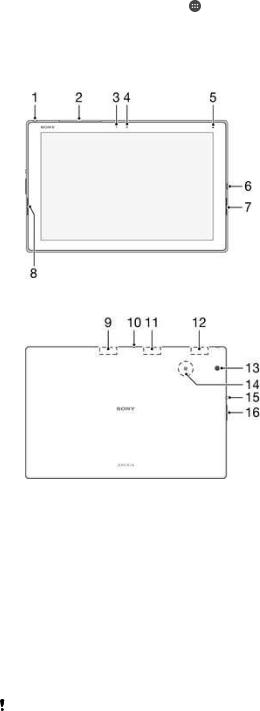
Getting started
About this User Guide
This is the Xperia™ Z4 Tablet User guide for the Android™ 6.0 software version. If you' re not sure which software version your device is running, you can check it via the
Settings menu. For more information about software updates, see Updating your device on the 107 page.
To Check the Current Software Version of Your Device
1 |
From your Home screen, tap . |
2 |
Find and tap Settings > About tablet. |
Overview
1. |
Headset jack* |
9. GPS antenna |
|
2. |
Memory card slot cover |
10. |
Microphone |
3. |
Light sensor |
11. |
Second Wi-Fi antenna area |
4. |
Front camera lens |
12. |
Main Wi-Fi/Bluetooth antenna area |
5. |
Charging/Notification light |
13. |
Main camera |
6. |
Charger/USB port |
14. |
NFC™ detection area |
7. |
Speaker |
15. |
Power key |
8. |
Speaker |
16. |
Volume/Zoom key |
Your device supports headsets with a standard 3.5 mm 3-pin or 5-pin headphone plug. The headset jack also supports 4-pin plugs as long as the headphone plug uses the CTIA standard.
6
This is an Internet version of this publication. © Print only for private use.
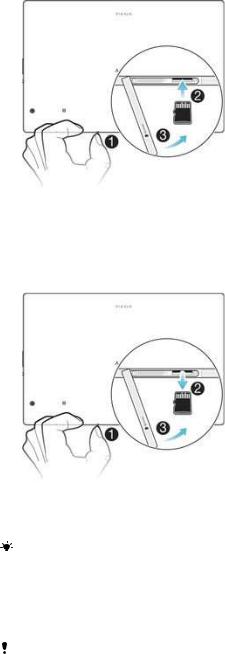
Assembly
A protective plastic sheet is attached to the screen. You should peel off this sheet before using the touchscreen. Otherwise, the touchscreen might not function properly.
To insert a memory card
1Detach the memory card slot cover.
2Place the memory card in the memory card slot, then push the memory card all the way into the slot until you hear a clicking sound.
3Re-attach the memory card slot cover.
To Remove the Memory Card
1Turn off the device and detach the memory card slot cover.
2Push the memory card inward, then release it quickly.
3Re-attach the cover.
You can also remove the memory card without turning the device off in step 1. To use this method, you must first unmount the memory card under Settings > Storage > Unmount SD
card, then follow the rest of the instructions above.
Screen protection
Before using your device, remove the transparent protection film by pulling up on the protruding tab.
It is recommended to protect your device with a Sony-branded screen cover or protector intended for your Xperia™ model. The use of third party screen protection accessories may prevent your device from working by covering sensors, lenses, speakers, or microphones and it can invalidate the warranty.
Starting your device for the first time
The first time you start your device, a setup guide opens to help you configure basic settings, sign in to online accounts, and personalize your device. For example, if you
7
This is an Internet version of this publication. © Print only for private use.
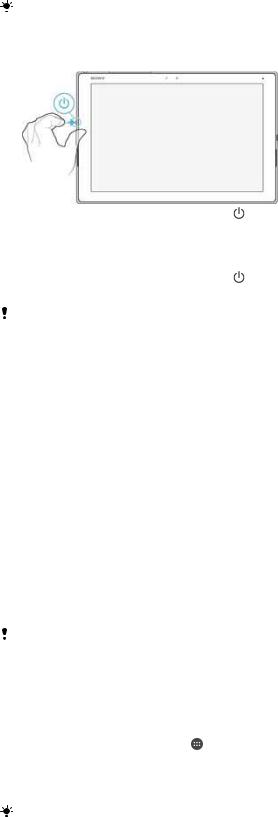
have a Sony Entertainment Network account, you can sign in to it here and get set up straight away.
You can also access the setup guide later from the Settings menu. To access the setup guide on a device with multiple users, you must be logged in as the owner, that is, the primary user.
To Turn on the Device
1 |
Press and hold down the power key |
until the screen flashes. |
2 |
Wait a while for the device to start. |
|
|
To Turn off the Device |
|
1 |
Press and hold down the power key |
until the options menu opens. |
2 |
In the options menu, tap Power off. |
|
It may take a while for the device to shut down.
Why do I need a Google™ account?
Your Xperia™ device from Sony runs on the Android™ platform developed by Google™. A range of Google™ applications and services is available on your device when you purchase it, for example, Gmail™, Google Maps™, YouTube™ and the Play Store™ application, which gives you access to the Google Play™ online store for downloading Android™ applications. To get the most out of these services, you need a Google™ account. For example, a Google™ account is mandatory if you want to:
•Download and install applications from Google Play™.
•Synchronize email, contacts and the calendar using Gmail™.
•Chat with friends using the Hangouts™ application.
•Synchronize your browsing history and bookmarks using the Google Chrome™ web browser.
•Identify yourself as the authorized user after a software repair using Xperia™ Companion.
•Remotely find, lock or clear a lost or stolen device using the my Xperia™ or Android™ Device Manager services.
For more information about Android™ and Google™, go to http://support.google.com.
It is crucial that you remember your Google™ account username and password. In some situations, you may need to identify yourself for security reasons using your Google™ account. If you fail to give your Google™ username and password in such situations, your device is locked. Also, if you have more than one Google™ account, make sure to enter the details for the relevant account.
To Set up a Google™ Account on Your Device 1 From your Home screen, tap .
2Find and tap Settings > Accounts > Add account > Google.
3Follow the registration wizard to create a Google™ account, or sign in if you already have an account.
You can also sign in to or create a Google™ account from the setup guide the first time you start your device. Or you can go online and create an account at www.google.com/accounts.
8
This is an Internet version of this publication. © Print only for private use.

Charging Your Device
Your device has an embedded, rechargeable battery that should only be replaced by Sony or an authorized Sony repair center. You should never try to open or take apart the device yourself. Opening the device can cause damage that voids your warranty.
The battery is partly charged when the device is shipped from the factory. Depending on how long your device was in the box before you purchased it, the battery level may be quite low. It is therefore recommended that you charge the battery for at least 30 minutes before starting up your device for the first time. You can still use your device while it is charging. To read more about how to improve the battery performance, see
Battery and power management on the 26page.
If your device gets exposed to water, wipe it dry with a microfiber cloth and shake the device at least 15 times with the USB port facing downward. Repeat the procedure if moisture is still visible in the USB port. Only insert the USB cable into the USB port after the port has completely dried.
To dry the USB port
1Using a microfiber cloth, wipe away any excess moisture from your device.
2With the device held firmly and the USB port facing downward, shake the device vigorously at least 15 times.
3If moisture is still visible in the USB port, shake the device again several times.
4Use a microfiber cloth to wipe away any remaining moisture from the USB port.
9
This is an Internet version of this publication. © Print only for private use.
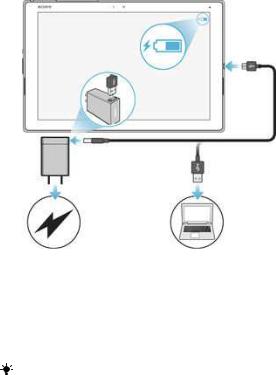
To charge your device
1Plug the charger into a power outlet.
2Plug one end of the USB cable into the charger (or into the USB port of a computer).
3Plug the other end of the cable into the micro USB port on your device, with the USB symbol facing up. The notification light illuminates when charging begins.
4When the device is fully charged, disconnect the cable from your device by pulling it straight outward. Make sure not to bend the connector.
If the battery is completely discharged, it may take a few minutes before the notification light illuminates and the charging icon  appears.
appears.
Battery notification light status
Green |
The battery is charging and the battery charge level is greater than 90% |
|
|
Red |
The battery is charging and the battery charge level is less than 15% |
|
|
Orange |
The battery is charging and the battery charge level is less than 90% |
|
|
10
This is an Internet version of this publication. © Print only for private use.

Device security
Making sure your device is protected
You can prevent other people from using your device without your permission. For example, if your device is lost, stolen, or wiped, only someone with your Google™ account or screen lock information can use the device. To make sure that your device is protected, it is important that you set a secure screen lock and add your Google™ account on your device. It is crucial that you remember both your screen lock information and your Google™ account credentials. To make sure your device is protected, you can:
•Set a secure screen lock on your device, that is, a PIN, password, or pattern screen lock to prevent anyone from resetting your device. For more information, see Screen lock on page 11 .
•Add a Google™ account to prevent others from using your device if it gets stolen and/or wiped. For more information, see Why do I need a Google™ account? on page 8 .
•Activate either the “Protection by my Xperia” or the Android™ Device Manager web service. Using one of these services, you can remotely locate, lock or erase a lost device. For more information, see Finding a lost device on page 17 .
Verifying the ownership of your device
When your device is protected, you need to either unlock your screen with your PIN, password, pattern, or enter your Google™ account information depending on the protection features you are using. Below are examples of protection features and some of the required credentials:
Factory Data |
You must unlock your screen before you are allowed to perform a Factory Data Reset. |
Reset protection |
|
Protection by my |
If you remotely reset your device using this service, you must enter the username and |
Xperia |
password for a Google™ account associated with the service. The device must be |
|
connected to the Internet before the setup process can be completed. Otherwise, you will |
|
not be able to use your device after the reset. |
Android™ |
If you remotely reset your device using this service, you must enter the username and |
Device Manager |
password for a Google™ account. The device must be connected to the Internet before |
|
the setup process can be completed. Otherwise, you will not be able to use your device |
|
after the reset. |
Software repair |
If you use the Xperia™ Companion software to perform a software repair, you’re asked to |
|
enter your Google™ account username and password when you start the device after the |
|
repair is complete. |
For Android™ Device Manager, it is necessary to enter information from a Google™ account. This can be any Google™ account which you have set up on the device. If you cannot provide the relevant account information during a setup process, you won't be able to use the device at all.
Screen lock
There are several ways to unlock the screen. The security level of each lock type is listed below in order of weakest to strongest:
•Swipe
–no protection, but you have quick access to the Home screen.
•Pattern
–draw a simple pattern with your finger to unlock your device.
•PIN
–enter a numeric PIN of at least four digits to unlock your device.
•Password
11
This is an Internet version of this publication. © Print only for private use.

– enter an alpha-numeric password to unlock your device.
It is very important that you remember your screen unlock pattern, PIN or password. If you forget this information, it may not be possible to restore important data such as contacts and messages.
If you have set up a Microsoft® Exchange ActiveSync® (EAS) account on your Xperia™ device, the EAS security settings may limit the lock screen type to only a PIN or password. This occurs when your network administrator specifies a specific lock screen type for all EAS accounts for enterprise security reasons. Contact the network administrator of your company or organization to check what network security policies are implemented for mobile devices.
To create a screen lock pattern 1 From your Homescreen, tap .
2Find and tap Settings > Security > Screen lock > Pattern.
3Follow the instructions on your device.
If your lock pattern is rejected five times in a row when you try to unlock your device, you must wait 30 seconds and then try again.
To change screen lock type
1 From your Homescreen, tap .
2Find and tap Settings > Security > Screen lock.
3Follow the instructions in your device and select another screen lock type.
To change the screen lock pattern 1 From your Home screen, tap .
2Find and tap Settings> Security > Screen lock.
3Draw your screen unlock pattern.
4Tap Pattern and follow the instructions on your device.
To Create a Screen Lock PIN 1 From your Home screen, tap .
2Find and tap Settings > Security > Screen lock > PIN.
3Enter a numeric PIN, then tap Continue.
4Re-enter and confirm your PIN, then tap OK.
5Follow the instructions on your device.
To Create a Screen Lock Password 1 From your Home screen, tap .
2Find and tap Settings > Security > Screen lock > Password.
3Enter a password, then tap Continue.
4Re-enter and confirm your password, then tap OK.
5Follow the instructions on your device.
To activate the Swipe unlock function 1 From your Home screen, tap .
2Find and tap Settings > Security > Screen lock.
3Draw your screen unlock pattern, or enter your PIN or password if one of these screen lock types is enabled.
4Tap Swipe.
Resetting a Forgotten Screen Lock
If you forgot your screen lock PIN, password, or pattern, you might be able to reset it using the Protection by my Xperia service. No content on your device is lost after you perform a screen lock reset using the Protection by my Xperia service.
To activate the Protection by my Xperia service, see Finding a lost device on the 17 page.
12
This is an Internet version of this publication. © Print only for private use.

To Reset the Screen Lock using Protection by my Xperia
1Make sure you know your Google™ account username and password and that you have enabled the Protection by my Xperia service on your device.
2Go to myxperia.sonymobile.com using any Internet-connected device.
3Sign in using the same Google™ account you have set up on your device.
4Click the picture of your device under Your devices.
5Select Lock or Change PIN2 to replace the current screen lock with a new PIN code.
6Follow the on-screen instructions provided by Protection by my Xperia.
Depending on your security settings, your device may lock after a screen lock reset. You then need to enter your Google™ account username and password in order to use the device.
Unlocking Your Device Automatically
The Smart Lock feature makes unlocking your device easier by letting you set it to unlock automatically in certain situations. You can keep your device unlocked, for example, when it’s connected to a Bluetooth® device or when you’re carrying it with you.
To prepare your device to unlock automatically, you first need to perform the following steps in the order given:
•Make sure you have an active Internet connection, preferably a Wi-Fi® connection to limit data traffic charges.
•Make sure all your apps are updated using the Play Store™ application in order to ensure that the Google Play™ services app is updated. Having an up-to-date Google Play™ services app ensures that you can use the latest Smart Lock features.
•Enable Smart Lock.
•Set when you want your device to unlock automatically.
The Smart Lock feature is developed by Google™ and the exact functionality may change over time due to updates from Google™.
The Smart Lock feature may not be available in every market, country, or region.
To Enable Smart Lock
1Make sure you’ve set a pattern, PIN, or password for your screen lock.
2From your Home screen, tap .
3Find and tap Settings > Security > Trust agents.
4Drag the slider beside Smart Lock (Google) to the right.
5Tap the back arrow next to Trust agents.
6Find and tap Smart Lock.
7Enter your pattern, PIN, or password. You need to enter this screen lock every time you want to change your Smart Lock settings.
8Select a Smart Lock type.
Setting When to Keep the Device Automatically Unlocked
You can set Smart Lock to keep your device unlocked using the following settings:
•Trusted devices – keep your device unlocked when a trusted Bluetooth® device is connected.
•Trusted places – keep your device unlocked when you' re in a trusted location.
•On-body detection – Keep your device unlocked when you' re carrying your device with you.
You have to manually unlock your device when you don' t use it for 4 hours and after you restart it.
Connecting to Trusted Bluetooth® Devices
You can designate a connected Bluetooth® device as a "trusted" device and keep your Xperia™ device unlocked while it’s connected to it. So if you have Bluetooth® devices you connect to regularly, for example, a car speaker or home entertainment system, a Bluetooth® watch, or a fitness tracker, you can add them as trusted devices and bypass
13
This is an Internet version of this publication. © Print only for private use.

the added security of a lockscreen to save time. This feature is suitable if you’re normally in a relatively secure place when you use these devices. In some cases, you may still need to manually unlock your device before a trusted device can be connected.
It is not recommended to add devices that are constantly connected to your device as trusted devices, for example, Bluetooth® keyboards or cases.
As soon as a trusted Bluetooth® device is switched off or moves out of range, your screen locks and you need your PIN, pattern, or password to unlock it.
To Add a Trusted Bluetooth® Device
1Make sure your device is paired and connected to the Bluetooth® device you want to add as a trusted device.
2In the Smart Lock menu, tap Trusted devices.
3Tap Add trusted device > Bluetooth.
4Tap a device name to select it from the list of connected devices. Only paired devices appear in this list.
5Depending on the security of your connection, you may need to manually unlock your device before the trusted device can keep it unlocked.
To Remove a Trusted Bluetooth® Device 1 From your Home screen, tap .
2Find and tap Settings > Security > Smart Lock > Trusted devices.
3Tap the device you want to remove.
4Tap Remove trusted device.
Making Sure You're Secure when Using Trusted Devices
Different Bluetooth® devices support different Bluetooth® standards and security capabilities. There' s a chance someone could keep your Xperia™ device unlocked by imitating your Bluetooth® connection, even if your trusted device is no longer nearby. Your device is not always able to determine whether your connection is secure from someone trying to imitate it.
When your device can' t determine that you' re using a secure connection, you' ll get a notification on your Xperia™ device and may need to manually unlock it before the trusted device can keep it unlocked.
Bluetooth® connectivity range can vary depending on factors like the model of your device, the connected Bluetooth® device, and your environment. Depending on these factors, Bluetooth® connections can work over distances of up to 325 feet (100 meters). If someone takes your Xperia™ device while it' s near a trusted device, they may be able to access your Xperia™ device if the trusted device has unlocked it.
Connecting to Trusted Places
When the Trusted places feature is set up, the lockscreen security on your Xperia™ device gets disabled when you are in a designated trusted location. For this feature to work, you must have an Internet connection (preferably over Wi-Fi® ) and allow your device to use your current location.
To set up trusted places, first make sure high-accuracy location mode or battery-saving location mode is enabled on your device before you add home or custom locations.
The exact dimensions of a trusted location are an estimate and may extend beyond the physical walls of your home or other area you have added as a trusted location. This feature can keep your device unlocked within a radius of up to 260 feet (80 meters). Also, be aware that location signals can be replicated or manipulated. Someone with access to specialized equipment could unlock your device.
14
This is an Internet version of this publication. © Print only for private use.

To Add Your Home Location
1Make sure location mode is turned on and you are using either the High accuracy or Battery saving setting.
2From your Home screen, tap .
3Find and tap Settings > Security > Smart Lock >Trusted places > Home.
4Tap Turn on this location.
To Edit Your Home Location
1Make sure location mode is turned on and you are using either the High accuracy or Battery saving setting.
2 From your Home screen, tap .
3Find and tap Settings > Security > Smart Lock > Trusted places.
4Select your home location.
5Tap Edit.
6In the search bar, enter the location you want to use as your home location.
If your home has multiple buildings at the same address, the trusted place you want to add might be different from the actual address. To ensure better location accuracy, you can add the actual location of your home within the building complex as a custom place.
To Remove Your Home Location
1Make sure location mode is turned on and you are using either the High accuracy or Battery saving setting.
2 From your Home screen, tap .
3Find and tap Settings > Security > Smart Lock >Trusted places > Home.
4Tap Turn off this location.
Using Custom Locations
You can add any location as a trusted, custom place where your device can remain unlocked.
To Add a Custom Place
1Make sure location mode is turned on and you are using either the High accuracy or Battery saving setting.
2 |
From your Home screen, tap . |
3 |
Find and tap Settings > Security > Smart Lock > Trusted places. |
4 |
Tap Add trusted place. |
5 |
To use your current location as a trusted, custom place, tap Select this location. |
6 |
Alternately, to enter another location, tap the magnification glass icon and type the |
|
address. Your device searches for the entered location. To use the suggested |
7 |
address, tap the address. |
To fine-tune the location, tap the back arrow next to the address, then drag the |
|
|
location pin to the desired location and tap Select this location. |
|
To Edit a Custom Place |
1 |
Make sure location mode is turned on and you are using either the High accuracy |
2 |
or Battery saving setting. |
From your Home screen, tap . |
3Find and tap Settings > Security > Smart Lock > Trusted places.
4Select the place you want to edit.
5Tap Edit address.
6To enter another location, tap the magnification glass icon and type the address. Your device searches for the entered location. To use the suggested address, tap the address.
7To fine-tune the location, tap the back arrow next to the address, then drag the location pin to the desired location and tap Select this location.
15
This is an Internet version of this publication. © Print only for private use.

To Remove a Custom Place
1Make sure location mode is turned on and you are using either the High accuracy or Battery saving setting.
2From your Home screen, tap .
3Find and tap Settings > Security > Smart Lock > Trusted places.
4Select the place you want to remove.
5Tap Delete.
Keeping Your Device Unlocked while You’re Carrying It
Using the On-body detection feature, you can have your device stay unlocked when you have it on you, for example, if you' re carrying it in your hand, pocket, or bag. The accelerometer in your device keeps your device unlocked when it senses that it' s being carried. The device locks when the accelerometer detects that the device has been put down.
The On-body detection feature can't distinguish whose body is connected. If you give your device to someone else while it's unlocked using On-body detection, your device may stay unlocked for the other user. Keep in mind that On-body detection as a security feature is less secure than a pattern, PIN, or password.
To enable On-body detection 1 From your Home screen, tap .
2Find and tap Settings > Security > Smart Lock > On-body detection.
3Drag the slider beside Off to the right, then tap Continue.
Using On-body Detection
When you use the On-body detection feature, you need to be aware of the following behaviors:
•When your device senses that it' s on your body, it stays unlocked after you unlock it.
•Any time you put your device down and it senses that it' s no longer on your body, your device locks automatically.
•After you put your device down, for example, if you place it on a table, your device can take up to one minute to lock.
•After you get into a car, bus, train, or other land vehicle, your device can take between 5 and 10 minutes to lock.
•Note that when you get on an airplane or a boat (or other non-land-based vehicles), your device may not lock automatically, so be sure to lock it manually if needed.
•When you pick up your device again or get out of the vehicle, just unlock it once and your device then stays unlocked for as long as you have it on you.
To turn off On-body detection 1 From your Home screen, tap .
2Find and tap Settings > Security > Smart Lock > On-body detection.
3Drag the slider beside On to the left.
Finding the identification number of your device
Your device has a unique ID (identification) number. You should keep a copy of this number. You may require it, for example, when you access the Xperia™ Care support service and need to register your device.
16
This is an Internet version of this publication. © Print only for private use.

To View the Device ID Number on the Label Tray
1Detach the memory card slot cover.
2Place your fingernail just under the tip on the label tray, then drag out the tray. The ID number is displayed on the tray.
To View the Device ID Number via the Device Settings 1 From your Home screen, tap .
2Find and tap Settings > About tablet > Status.
3Scroll to IDID to view the ID number.
Finding a lost device
If you have a Google™ account, the “Protection by my Xperia” web service can help you locate and secure your device if you ever lose it. If you have activated this service on your device or at myxperia.sonymobile.com , you can:
•Locate your device on a map.
•Sound an alert, even if the device is in silent mode.
•Remotely lock the device.
•Remotely clear the internal and external memory of the device as a last resort.
The “ Protection by my Xperia” service may not be available in all countries/regions.
To Activate the Protection by my Xperia Service on Your Device
1Make sure you have an active data connection.
2From your Home screen, tap .
3Find and tap Settings > Security > Protection by my Xperia > Activate.
4If you are activating the service for the first time, mark the checkbox to agree with
the terms and conditions of using the Protection by my Xperia service, then tap
Accept.
5If prompted, sign in to your Google™ account, or create a new one if you don’t have one.
6Enable location services on your device if this function is not already enabled.
To verify that the Protection by my Xperia service can locate your device after you activate the service, go to myxperia.sonymobile.com and sign in using the Google™ account that you have set up on your device.
If you are using a device with multiple users, note that the Protection by my Xperia service is only available to the user who is logged in as the owner.
17
This is an Internet version of this publication. © Print only for private use.

Lockdown Mode
Lockdown mode is a feature of the Protection by my Xperia service. It gets enabled when unusual activity is detected on your device. Once your device goes into lockdown mode, you must sign in to your Google™ account to reactivate your device and recover it from lockdown mode.
To prevent your device from being used or sold by thieves, lockdown mode does the following:
•Stops or disables all running applications.
•Limits access to notifications.
•Disables USB and Bluetooth® connections.
If you delete your Google™ account permanently via your Google™ Account Settings page at https://myaccount.google.com , it becomes impossible to recover your device from lockdown mode or deactivate the Protection by my Xperia service. If, for some reason, you delete your Google™ account in this way, you only have a limited amount of time in which to restore it.
Actions that trigger lockdown mode
Lockdown mode is triggered in the following situations:
•During a factory reset procedure.
•When Xperia™ Companion is used to wipe out user data.
•When the Google™ account that was used to activate Protection by my Xperia on your device gets removed from your device (but not permanently deleted).
•When someone removes or tampers with security features on your device, for example, when someone tries to input the credentials for the Google™ account that you’ve used to activate Protection by my Xperia on your device but fails more than three times in a row.
If you don't want lockdown mode to get triggered by any of the above actions or situations, you can deactivate the Protection by my Xperia service.
To Recover the Device from Lockdown Mode
1On the lockdown screen, tap Authenticate.
2To complete the recovery procedure, sign in using the Google™ account that was used to activate the Protection by my Xperia service.
Make sure you have a working Internet connection when recovering your device from lockdown mode.
To Deactivate Protection by my Xperia 1 From your Home screen, tap .
2Find and tap Settings > Security > Protection by my Xperia.
3Tap Deactivate, then confirm deactivation.
4To complete the procedure, sign in using the Google™ account that was used to activate the Protection by my Xperia service.
18
This is an Internet version of this publication. © Print only for private use.
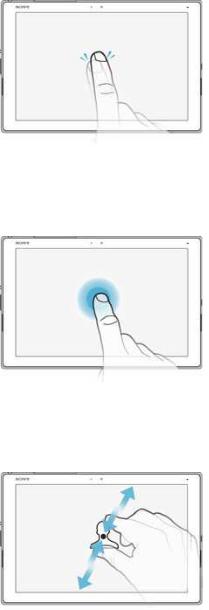
Learning the basics
Using the touchscreen
Tapping
•Open or select an item.
•Mark or unmark a checkbox or option.
•Enter text using the on-screen keyboard.
Touching and holding
•Move an item.
•Activate an item-specific menu.
•Activate selection mode, for example, to select several items from a list.
Pinching and spreading
•Zoom in or out on web pages, photos, and maps, and when you’re taking photos or shooting videos.
19
This is an Internet version of this publication. © Print only for private use.

Swiping
•Scroll up or down a list.
•Scroll left or right, for example, between Home screen panes.
Flicking
•Scroll quickly, for example, in a list or on a web page. You can stop the scrolling movement by tapping the screen.
Locking and Unlocking the Screen
When your device is on and left idle for a set period of time, the screen darkens to save battery power and locks automatically. This lock prevents unwanted actions on the touchscreen when you are not using it. When you buy your device, a basic screen swipe lock is already set. This means you have to swipe upward on the screen to unlock it. You can change the security settings later and add other kinds of locks. See Screen lock on the 11 page.
To activate the screen
•Briefly press the power key  .
.
To lock the screen
•When the screen is active, briefly press the power key  .
.
Home screen
The Home screen is the starting point for using your device. It' s similar to the desktop on a computer screen. Your Home screen can have up to seven panes, which extend beyond the regular screen display width. The number of Home screen panes is represented by a series of dots at the lower part of the Home screen. The highlighted dot shows the pane that you are currently in.
20
This is an Internet version of this publication. © Print only for private use.
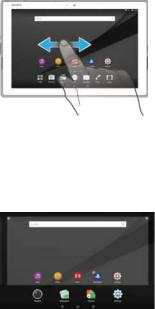
To go to the Home screen
•Press  .
.
To browse the Home screen
Home screen panes
You can add new panes to your Home screen (up to a maximum of seven panes) and delete panes. You can also set the pane that you want to use as the main Home screen pane.
To set a pane as the main Home screen pane
1Touch and hold an empty area on your Home screen.
2Flick left or right to browse to the pane that you want to set as your main Home screen pane, then tap  .
.
To add a pane to your Homescreen
1Touch and hold an empty area on your Home screen until the device vibrates.
2To browse the panes, flick all the way to the right or left, then tap  .
.
To Delete a Pane from your Homescreen
1Touch and hold any area on your Homescreen until the device vibrates.
2Flick left or right to browse to the pane you want to delete, then tap  in the topright corner of the pane.
in the topright corner of the pane.
Homescreen Settings
Use the Home Settings shortcut to adjust some basic settings on your Homescreen. For example, you can set your Homescreen to auto-rotate and adjust the size of icons.
To Set Your Homescreen to Auto-Rotate
1Touch and hold an empty area on your Homescreen until the device vibrates, then tap Home Settings.
2Drag the slider beside Auto rotation to the right.
To Adjust the Size of Icons on Your Homescreen
1Touch and hold an empty area on your Homescreen until the device vibrates, then tap Home Settings.
2Tap Icon size, then select an option.
Application screen
The Application screen, which you open from the Homescreen, contains the applications that come pre-installed on your device as well as applications that you download.
21
This is an Internet version of this publication. © Print only for private use.

|
To view all applications on the Application screen |
1 |
From your Home screen, tap . |
2 |
Flick left or right on the Application screen. |
|
To open an application from the Application screen |
• |
Flick left or right to find the application, then tap the application. |
|
To Search for an Application from the Application Screen |
1 |
When the Application screen is open, tap . |
2 |
Enter the name of the application you want to search for. |
|
To open the Application screen menu |
• |
When the Application screen is open, drag the left edge of the screen to the right. |
|
To Move an Application on the Application Screen |
1 |
When the Application screen is open, tap . |
2 |
Make sure Own order is selected under Sort apps. |
3 |
Touch and hold the application until it becomes selected, then drag it to the new |
location.
To add an application shortcut to the Home screen
1On the Application screen, touch and hold an application icon until it becomes selected, then drag the icon to the top of the screen. The Home screen opens.
2Drag the icon to the desired location on the Home screen, then release your finger.
To Arrange Applications on the Application Screen
1When the Application screen is open, tap .
2Tap Sort apps, then select an option.
To uninstall an application from the Application screen
1 Touch and hold any area on the Application screen until the device vibrates. All
applications that can be uninstalled are then indicated by .
2 Select the application that you want to uninstall, then tap Delete.
Navigating Applications
You can navigate between applications using the navigation keys, the favorites bar, and the recently used applications window, which lets you switch easily between all recently used applications. The navigation keys are the Home key, the Recent apps key, and the Back key. Some applications get closed when you press the Home key  to exit, while others are paused or continue to run in the background. If an application is paused or running in the background, you can continue where you left off the next time you open the application.
to exit, while others are paused or continue to run in the background. If an application is paused or running in the background, you can continue where you left off the next time you open the application.
22
This is an Internet version of this publication. © Print only for private use.

1 Recently used applications window – Open a recently used application
2Favorites bar – Use a shortcut to access applications or widgets
3 Recent apps key – Open the recently used applications window and the favorites bar
4Home key – Exit an application and go back to the Homescreen
5Back key – Go back to the previous screen within an application or close the application
To open the recently used applications window
•Press  .
.
To Close All the Recently Used Applications
•Tap  and then tap
and then tap  .
.
To open a menu in an application
•While using the application, press  .
.
A menu is not available in all applications.
Small apps
Small apps are miniature apps that run on top of other applications on the same screen, to enable multi-tasking. For example, you can have a webpage open showing details of currency exchange rates, and then open the Calculator small app on top of it and perform calculations. You can access your small apps via the favorites bar. To download more small apps, go to Google Play™.
To open a small app
1To make the favorites bar appear, press  .
.
2Tap the small app that you want to open.
You can open several small apps at the same time.
To close a small app
• |
Tap on the small app window. |
|
|
To download a small app |
|
1 |
From the favorites bar, tap |
, then tap and tap . |
2 |
Search for the small app that you want to download, then follow the instructions |
|
to download it and complete the installation.
To move a small app
•When the small app is open, touch and hold the top left corner of the small app, then move it to the desired location.
To minimize a small app
•When the small app is open, touch and hold the top left corner of the small app, then drag it to the right edge or to the bottom edge of the screen.
23
This is an Internet version of this publication. © Print only for private use.

To rearrange the small apps in the favorites bar
•Touch and hold a small app and drag it to the desired position.
To remove a small app from the favorites bar 1 Touch and hold a small app, then drag it to .
2Tap OK.
To restore a previously removed small app
1Open the favorites bar, then tap  .
.
2Touch and hold the small app you want to restore, then drag it into the favorites bar.
To add a widget as a small app
1To make the favorites bar appear, press  .
.
2Tap  >
>  >
>  .
.
3Select a widget.
4Enter a name for the widget, if desired, then tap OK.
Widgets
Widgets are small applications that you can use directly on your Homescreen. They also function as shortcuts. For example, the Weather widget allows you to see basic weather information directly on your Homescreen. But when you tap the widget, the full Weather application opens. You can download additional widgets from Google Play™.
To add a widget to the Home screen
1Touch and hold an empty area on your Home screen, then tap Widgets.
2Find and tap the widget that you want to add.
To Resize a Widget
1Touch and hold a widget until it is selected, then release the widget. If the widget can be resized, for example, the Calendar widget, then a highlighted frame and resizing dots appear.
2Drag the dots inward or outward to shrink or expand the widget.
3To confirm the new size of the widget, tap anywhere on the Home screen.
To Move a Widget
•Touch and hold the widget until it is selected, then drag it to the new location.
To Remove a Widget
•Touch and hold the widget until it is selected, then drag it to Remove from Home screen.
Shortcuts and folders
Use shortcuts and folders to manage your applications and keep your Home screen tidy.
24
This is an Internet version of this publication. © Print only for private use.

Shortcuts and Folders Overview
1 Access an application by using a shortcut
2Access a folder containing applications
To add an application shortcut to your Home screen
1Touch and hold an empty area on your Home screen.
2In the customization menu, tap Widgets > Apps.
3Scroll through the list of applications and select an application. The selected application gets added to the Home screen.
In step 3, alternatively, you can tap Widgets > Shortcuts and then select an application from the list available. If you use this method to add shortcuts, some of the applications available allow you to add specific functionality to the shortcut.
To Move an Item on the Homescreen
•Touch and hold the item until it is selected, then drag the item to the new location.
To Remove an Item from the Homescreen
•Touch and hold the item until it becomes selected, then drag the item to Remove from Home screen at the top of the screen.
To Create a Folder on the Homescreen
•Touch and hold an application icon or a shortcut until it is selected, then drag and drop it on top of another application icon or shortcut.
To Add Items to a Folder on the Homescreen
•Touch and hold an item until it is selected, then drag the item to the folder.
To rename a folder on the Home screen
1Tap the folder to open it.
2Tap the folder' s title bar to show the Folder name field.
3Enter the new folder name and tap Done.
Background and Themes
You can adapt the Homescreen to your own style using wallpapers and different themes.
To change your Home screen wallpaper
1Touch and hold an empty area on your Home screen.
2Tap Wallpapers and select an option.
25
This is an Internet version of this publication. © Print only for private use.

To set a theme
1Touch and hold an empty area on your Home screen.
2Tap Themes.
3Select an option and follow the instructions in your device.
When you change a theme, the background also changes in some applications.
Battery and power management
Your device has an embedded battery. You can keep track of your battery consumption
and see how much power applications are using. You can remove apps and activate Battery saver to get more out of your battery. You can also view an estimate of how
much battery time is left and adjust your settings to improve performance and make your battery last longer.
To view your battery consumption and estimated battery time 1 From your Home screen, tap .
2Find and tap Settings > Battery usage. An overview appears showing battery usage data and an estimated battery time.
3Review the information, then proceed as required, for example, uninstall an application or restrict its usage.
To view how much battery power applications use 1 From your Home screen, tap .
2Find and tap Settings > Apps.
3Select an application and review its battery consumption via App info > Battery usage.
Taking a screenshot
You can capture still images of any screen on your device as a screenshot. Screenshots you take are automatically saved in Album.
To Take a Screenshot
1Press and hold down the power key until a prompt window appears.
2Tap  .
.
You can also take a screenshot by pressing and holding down the power key and volume down key at the same time. Once the screenshot is captured, you can release the keys.
To view your screenshot
•Drag the status bar fully downwards, then tap the screenshot you want to view.
You can also view your screenshots by opening the Album application.
Recording your screen
You can use the screen recording feature to capture videos of what’s happening on your device’s screen. This feature is useful, for example, when you want to create tutorials or record videos of you playing a game on your device. Recorded video clips are automatically saved in Album.
Shortcuts and folders overview
1 Minimize/Restore the screen recording window
2Record your screen
26
This is an Internet version of this publication. © Print only for private use.
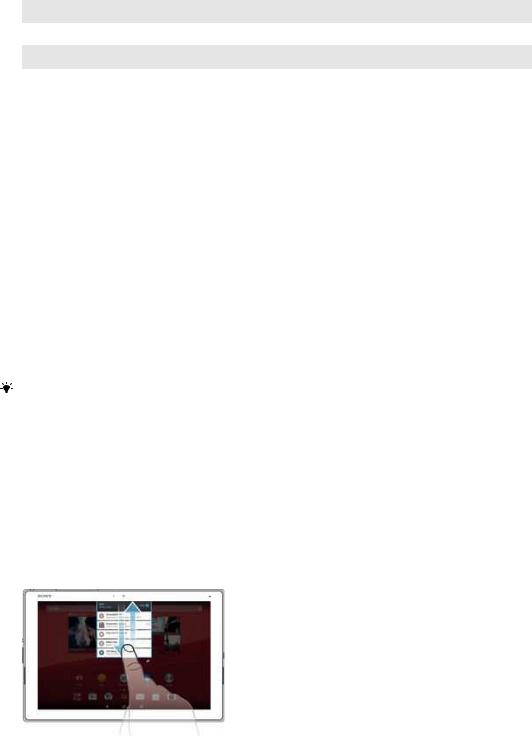
3 Record your screen when the front camera is activated
4Record your screen with audio
5 Access the screen recording settings
6Close the screen recording window
To record your screen
1Press and hold down the power key until a prompt window appears.
2Tap  .
.
3After the screen recording window opens, tap  . The record screen function starts and a timer button is displayed.
. The record screen function starts and a timer button is displayed.
4To stop the recording, tap the timer button, then tap  .
.
To record your screen when the front camera is activated
1When the screen recording window opens, tap  . A window opens showing a viewfinder for the front camera.
. A window opens showing a viewfinder for the front camera.
2To start recording your screen and video captured by the front camera, tap  .
.
3To stop recording, tap the timer button, then tap  .
.
4To close the front camera viewfinder window, tap  .
.
To view recent screen recordings
•Drag the status bar downward, then tap to view the most recent recordings of your screen.
You can also view your screen recordings in the Album application.
Notifications
Notifications inform you of events such as new messages and calendar notifications as well as activities in progress, such as file downloads. Notifications appear in the following places:
•The status bar
•The Notification panel
•The lockscreen
To open or close the Notification panel
1To open the Notification panel, drag the status bar downward.
2To close the Notification panel, drag the panel upward.
To Take Action on a Notification in the Notification Panel
•Tap the notification.
To dismiss a notification from the Notification panel
•Place your finger on a notification and flick left or right.
To Clear all Notifications from the Notification PanelS
•Tap  .
.
27
This is an Internet version of this publication. © Print only for private use.
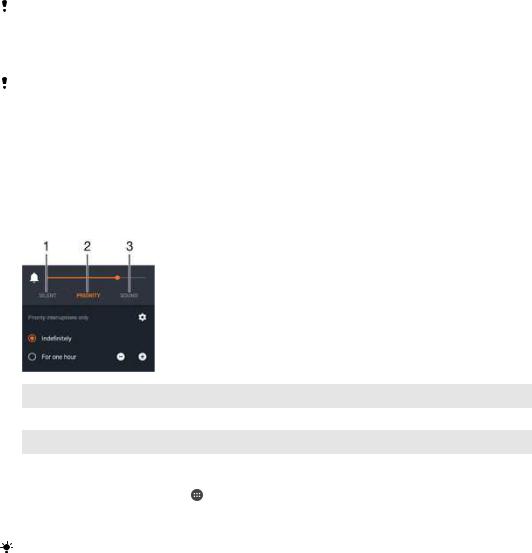
To Take Action on a Notification from the Lockscreen
•Double-tap the notification.
To dismiss a notification from the lockscreen
•Place your finger on the notification and flick left or right.
To Expand a Notification on the Notification Panel
•Drag the notification downward.
Not all notifications are expandable.
To Expand a Notification on the Lockscreen
•Drag the notification downward.
Not all notifications are expandable.
Quick settings for interruptions
There are three modes available for interruptions on your device: Total silence, Priority only, and Sound. Within each mode, you can determine how and when notifications can
interrupt you, if at all. For example, you can set your device to only show you priority notifications during the hours you’re at work or block all notifications while you’re taking a nap. You can get quick access to the basic interruption and sound settings by pressing the volume key up or down.
1 Total silence – All interruptions get blocked, excluding alarms. There is still sound when alarms go off
2 Priority only – Only allow priority interruptions
3Sound – Allow all interruptions
To set priority interruptions
1 From your Home screen, tap .
2Find and tap Settings > Sound & notification > @*android:string/ zen_mode_feature_name.
For more information about settings for notifications and interruptions, see Notifications on page 27 .
Notification Light
The notification light informs you about battery status and some other events. The notification light is enabled by default but can be disabled manually.
28
This is an Internet version of this publication. © Print only for private use.
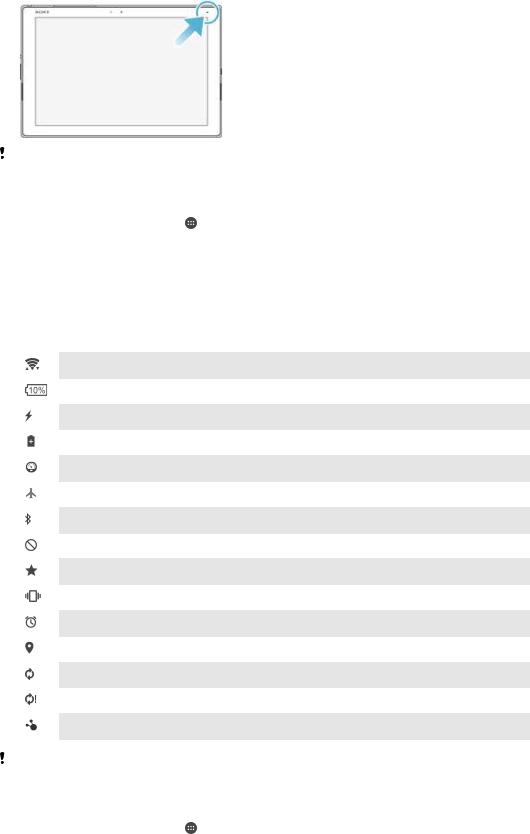
When the notification light is disabled, it only lights up when there is a battery status warning, such as when the battery level falls below 15 percent.
To Enable the Notification Light 1 From your Homescreen, tap .
2Find and tap Settings > Sound & notification.
3Drag the slider beside Notification light to the right.
Icons in the status bar
Status icons
A Wi-Fi® connection is enabled and data is being transmitted
Battery status
The battery is charging
Battery saver is activated
Low battery mode is activated
Airplane mode is activated
The Bluetooth® function is activated
Silent mode
Only allow priority interruptions
Vibrate mode
An alarm is set
GPS is activated
Synchronization is ongoing
Problem with sign-in or synchronization
Your device is ready to connect to supported ANT+™ devices
Depending on your service provider and/or region, the functions or services represented by some icons in this list may not be available.
To Manage Status Bar Icons 1 From your Homescreen, tap .
2Find and tap Settings > Display > System icons.
3Mark the checkboxes for the system icons that you want to appear in the status bar.
29
This is an Internet version of this publication. © Print only for private use.
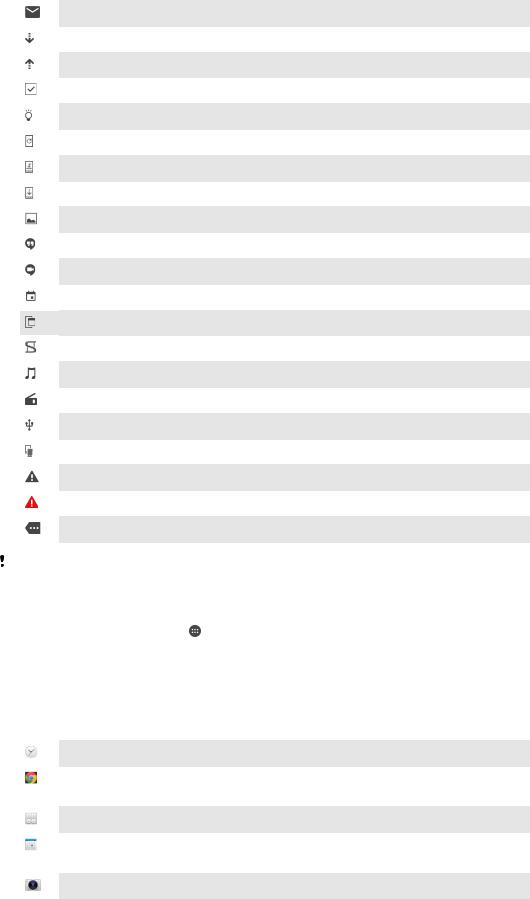
Notification Icons
New email message
Downloading data
Uploading data
Perform a basic setup guide of your device
A software update is available
System updates are available
Downloading system updates
Tap to install the downloaded system updates
Screenshot captured
A new Hangouts™ chat message has arrived
Video chat with friends using the Hangouts™ application
Upcoming calendar event
A small app is running
Smart Connect is activated
A song is playing
The radio is playing
The device is connected to a computer via a USB cable
Internal storage is 75% full. Tap to transfer data to the memory card Warning
Error message
More (undisplayed) notifications
Not all icons that may appear on your device are listed here. These icons are for reference purposes only, and changes may be made without notice.
To block an application from sending notifications 1 From your Home screen, tap .
2Find and tap Settings > Sound & notification> App notifications.
3Select an application.
4Drag the slider beside Block all to the right.
Application Overview
Use the Alarm & clock application to set various kinds of alarms.
Use your web browser to navigate and view web pages and manage bookmarks, text and images.
Use the Calculator application to perform basic calculations.
Use the Calendar application to keep track of events and manage your appointments.
Use the camera to take photos and record video clips.
30
This is an Internet version of this publication. © Print only for private use.
